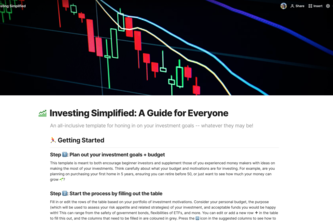Dividend Investing Simplified: A Guide To Maximum Profits

Table of Contents
Understanding Dividend Investing Basics
Dividend investing involves purchasing stocks in companies that regularly distribute a portion of their profits to shareholders as dividends. This offers several key benefits:
- Passive Income: Receive regular cash payments, supplementing your income.
- Potential for Capital Appreciation: The value of your stock holdings can increase over time, leading to capital gains.
- Inflation Hedge: Dividends can help offset the effects of inflation, preserving your purchasing power.
Understanding the difference between dividend yield and payout ratio is crucial:
-
Dividend Yield: Represents the annual dividend payment relative to the stock's price (Annual Dividend per Share / Stock Price). A higher yield generally indicates a larger dividend payment but doesn't always reflect the health of the company. For example, a stock with a $2 annual dividend and a $50 price has a 4% yield.
-
Payout Ratio: Shows the percentage of earnings a company pays out as dividends (Annual Dividends / Net Income). A lower payout ratio suggests the company is retaining more earnings for reinvestment, which can fuel future growth. A high payout ratio might be a red flag, suggesting the company's future dividend sustainability is questionable.
While dividend investing offers substantial potential, it's important to acknowledge the risks:
- Company Performance: If a company's performance declines, it may reduce or eliminate dividends.
- Market Fluctuations: Stock prices can fluctuate significantly, impacting both your dividend income and the overall value of your portfolio.
Key aspects of dividend investing:
- What are dividends? A portion of a company's profits distributed to shareholders.
- How are dividends paid? Typically paid quarterly, directly deposited into your brokerage account.
- The importance of dividend reinvestment plans (DRIPs): Automatically reinvest dividends to buy more shares, accelerating growth through compounding.
- Tax implications of dividend income: Dividends are typically taxed as ordinary income, but specific tax rates vary depending on your location and income bracket.
Identifying High-Yield Dividend Stocks
Due diligence is paramount when selecting dividend stocks. Thorough research is key to identifying promising opportunities. Here's how:
-
Screening Methods: Utilize financial websites and stock screeners to filter stocks based on criteria like dividend yield, payout ratio, and dividend growth history. Look for companies with a consistent history of increasing dividends.
-
Reliable Resources: Leverage reputable sources like Yahoo Finance, Google Finance, Bloomberg, and others for in-depth financial analysis. Many offer stock screeners allowing you to filter by your chosen criteria.
-
Diversification: Don't put all your eggs in one basket. Spread your investments across various sectors and companies to mitigate risk.
Analyzing Company Fundamentals:
-
Analyzing company financials: Scrutinize balance sheets, income statements, and cash flow statements to assess the company's financial health and stability.
-
Assessing competitive advantage and future prospects: Evaluate the company's market position, competitive advantages, and growth potential. Is it a leader in its industry? Does it have a strong moat protecting it from competition?
-
Identifying red flags: Watch out for high debt levels, declining earnings, and negative cash flow, which can indicate financial instability.
-
The importance of long-term investing: Dividend investing is a long-term strategy. Patience and discipline are crucial for reaping the rewards.
Building and Managing Your Dividend Portfolio
Building a successful dividend portfolio requires a well-defined strategy:
-
Portfolio Strategies: Consider various approaches, such as value investing (focus on undervalued companies), growth investing (focus on companies with high growth potential), or dividend growth investing (focus on companies with a consistent history of increasing dividends).
-
Asset Allocation and Diversification: Distribute your investments across different asset classes (stocks, bonds, etc.) and sectors to reduce risk. Diversify geographically as well if possible.
-
Regular Portfolio Review and Rebalancing: Periodically review your portfolio's performance and rebalance it to maintain your desired asset allocation.
-
Dollar-Cost Averaging (DCA): Invest a fixed amount of money at regular intervals, regardless of market fluctuations. This mitigates the risk of investing a lump sum at a market high.
Practical steps in portfolio management:
-
Setting investment goals and timelines: Define your investment objectives (e.g., retirement income, supplementing current income) and establish a realistic timeline.
-
Choosing a brokerage account: Select a brokerage account that aligns with your investment needs and offers the tools and resources you require.
-
Implementing a buy-and-hold strategy: A long-term strategy where you buy and hold your investments for an extended period, regardless of short-term market fluctuations.
-
Tax-efficient investing strategies: Utilize tax-advantaged accounts (e.g., IRAs, 401(k)s) to minimize your tax burden on investment gains and dividend income.
Maximizing Your Dividend Profits
Several strategies can help maximize your dividend income:
-
Reinvesting Dividends: Utilize DRIPs or reinvest dividends automatically to buy more shares, accelerating the power of compounding.
-
Dividend Growth Stocks: Focus on companies with a history of consistently increasing their dividend payments over time.
-
Tax Optimization: Utilize tax-efficient investment strategies to minimize your tax liability on dividend income.
-
Dividend ETFs: Consider investing in dividend ETFs, which offer diversification across a range of dividend-paying stocks.
Key considerations for maximizing returns:
-
The power of compounding: Reinvesting dividends allows your earnings to generate further earnings, exponentially increasing your wealth over time.
-
The impact of inflation on dividend income: Ensure your dividend income keeps pace with inflation to maintain your purchasing power.
-
Long-term vs. short-term dividend investing: A long-term perspective is crucial for realizing the full potential of dividend investing.
-
Seeking professional advice when necessary: Consult a financial advisor for personalized guidance, particularly if you have complex financial situations.
Reap the Rewards of Simplified Dividend Investing
By understanding the basics of dividend investing, conducting thorough research, building a diversified portfolio, and employing smart strategies, you can create a sustainable stream of passive income. Remember that consistent effort and informed decisions are crucial for maximizing your profits. Dividend investing is a marathon, not a sprint.
Start your journey towards financial freedom today. Learn more about effective dividend investing strategies and begin building your portfolio. Don't miss out on the potential of dividend investing to secure your financial future. Explore our resources for more information on maximizing your dividend profits and achieving your financial goals through consistent and informed dividend investing.

Featured Posts
-
 Virginia Giuffre Prince Andrew Accuser Involved In Car Accident Four Day Deadline Claim
May 11, 2025
Virginia Giuffre Prince Andrew Accuser Involved In Car Accident Four Day Deadline Claim
May 11, 2025 -
 Grand Slam Updates Stay Informed With The Jamaica Observer
May 11, 2025
Grand Slam Updates Stay Informed With The Jamaica Observer
May 11, 2025 -
 James Gunn Confirms Henry Cavills Difficult Dc Experience
May 11, 2025
James Gunn Confirms Henry Cavills Difficult Dc Experience
May 11, 2025 -
 Competing With Tik Tok Key Takeaways From Instagram Ceos Testimony
May 11, 2025
Competing With Tik Tok Key Takeaways From Instagram Ceos Testimony
May 11, 2025 -
 Rozmova Putina I Trampa Reaktsiya Borisa Dzhonsona Ta Yiyi Naslidki
May 11, 2025
Rozmova Putina I Trampa Reaktsiya Borisa Dzhonsona Ta Yiyi Naslidki
May 11, 2025
